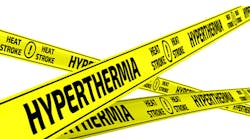In the summer of 2011 Amazon.com was in the news everywhere, including national television, but not for some Internet innovation or a new consumer offer. Instead, viewers were confronted with pictures of an Amazon warehouse facility in Allentown, Pa., where an ambulance and paramedics were stationed around the clock in the parking lot to treat employees suffering from heat exhaustion.
It turned out that during summer, when temperatures sometimes reached as high as 114 degrees within the facility, employees routinely showed all of the symptoms of severe heat illness up to and including collapsing unconscious.
The news story shocked people who are unaware that temperatures can be extreme in facilities that are so big that it is nearly impossible to air condition them economically. Because Amazon initially did little to address the concerns of the workers, whose primary employer was a temporary staffing agency, they turned to the Occupational Safety and Health Administration (OSHA).
In 2012 Amazon sought to cool this bad publicity by investing $52 million (representing 8.2% of its 2011 earnings) to add temperature control to its facilities nationwide, although skeptics said it had more to do with the company branching out to sell food and electronic products.
Because of this and similar problems uncovered at facilities owned by Amazon and other warehouse operators, OSHA has made heat protection an enforcement priority in recent years, in addition to its targeting of other industries where heat danger traditionally is high, such as agriculture and construction.
The federal agency has no established heat illness standard, but it can and does rely on the General Duty Clause contained in its enabling law, which requires employers to provide employees with a workplace free from recognized hazards likely to cause death or serious physical harm. OSHA is not shy about issuing citations to employers for incidents involving heat illness, and the penalties it assesses can be steep—as much as $70,000 in one case.
How to Beat the Heat
OSHA has not been stingy in offering advice to employers about how to prepare for and deal with the issue. For example, it offers a heat safety tool, available in both English and Spanish, which can be downloaded on an iPhone or Android device.
“Employers can and should take advantage of this free app, which calculates the heat index for the worksite and displays a risk level,” says attorney Valerie Butera of the law firm of Epstein Becker Green. The app also provides a list of the measures that should be taken at that risk level to protect workers from developing heat illness.
Butera urges employers to have a heat illness prevention plan in place and make sure that their employees fully understand the dangers of heat illness and how to avoid it. “By taking just a few extra precautions, employers can significantly reduce the possibility of workers being affected by heat illness and demonstrate their commitment to worker safety,” she says.
Among the simple steps OSHA advises every employer to take are:
• Designate a person to oversee a Heat Illness Prevention Program and enforce its requirements.
• Provide air-conditioned or shaded areas close to the work area and schedule frequent rest breaks. Implement more frequent breaks during the first week of work in high-heat conditions and develop a work/rest regimen that establishes how often and when breaks should be taken.
• Provide workers with plenty of cool drinking water in convenient, visible locations close to the work area. Encourage and remind workers to drink water before they become thirsty. One cup every 15 minutes is considered a good rule of thumb.
• Make work schedule changes as appropriate. Examples include: rescheduling all non-essential outdoor work for days with a reduced heat index; scheduling more physically demanding work during the cooler times of day and the less physically demanding work when it is warmer; and rotating workers or using split shifts and stopping work if essential control methods are inadequate or unavailable when the risk of heat illness is very high.
• When they work outside, such as in delivery operations, encourage employees to wear or provide employees with light-colored and permeable clothing and consider whether other controls can be implemented.
• Monitor workers for signs and symptoms of heat exposure and encourage employees to report symptoms of any heat-related illnesses. Have workers partner with each other and watch out for signs of heat-related illness in their co-workers.
• Train workers and supervisors about the hazards leading to heat stress and ways to recognize heat-related illness in themselves and others, ways to prevent heat-related illness, and awareness of first-aid procedures.
• Implement an emergency action plan and know what to do if someone is experiencing symptoms of a heat-related illness.
Additional resources are available on the OSHA website.
Employers in California also need to adhere to much stricter standards that have been imposed by state regulators in recent years. Cal/OSHA inspectors work from more comprehensive heat illness regulations. These include requiring employers in the state to take additional proactive steps aimed at preventing heat illness.
Instead of solely focusing on the temperature, weather and setting of the day, these guidelines emphasize the importance of training employees to recognize the signs of heat illness, and for supervisors to recognize and deal with the same signs in their employees.
Resources for California employers are available on the Cal/OSHA website.




